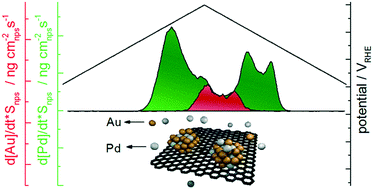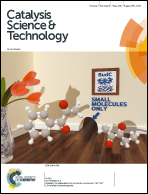Addressing stability challenges of using bimetallic electrocatalysts: the case of gold–palladium nanoalloys†
Abstract
Bimetallic catalysts are known to often provide enhanced activity compared to pure metals, due to their electronic, geometric and ensemble effects. However, applied catalytic reaction conditions may induce re-structuring, metal diffusion and dealloying. This gives rise to a drastic change in surface composition, thus limiting the application of bimetallic catalysts in real systems. Here, we report a study on dealloying using an AuPd bimetallic nanocatalyst (1 : 1 molar ratio) as a model system. The changes in surface composition over time are monitored in situ by cyclic voltammetry, and dissolution is studied in parallel using online inductively coupled plasma mass spectrometry (ICP-MS). It is demonstrated how experimental conditions such as different acidic media (0.1 M HClO4 and H2SO4), different gases (Ar and O2), upper potential limit and scan rate significantly affect the partial dissolution rates and consequently the surface composition. The understanding of these alterations is crucial for the determination of fundamental catalyst activity, and plays an essential role for real applications, where long-term stability is a key parameter. In particular, the findings can be utilized for the development of catalysts with enhanced activity and/or selectivity.

- This article is part of the themed collection: 2017 Catalysis Science & Technology HOT Articles


 Please wait while we load your content...
Please wait while we load your content...